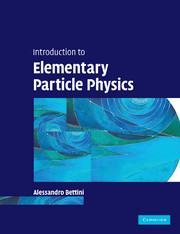Book contents
- Frontmatter
- Contents
- Preface
- Acknowledgments
- 1 Preliminary notions
- 2 Nucleons, leptons and bosons
- 3 Symmetries
- 4 Hadrons
- 5 Quantum electrodynamics
- 6 Chromodynamics
- 7 Weak interactions
- 8 The neutral K and B mesons and CP violation
- 9 The Standard Model
- 10 Beyond the Standard Model
- Appendix 1 Greek alphabet
- Appendix 2 Fundamental constants
- Appendix 3 Properties of elementary particles
- Appendix 4 Clebsch–Gordan coefficients
- Appendix 5 Spherical harmonics and d-functions
- Appendix 6 Experimental and theoretical discoveries in particle physics
- Solutions
- References
- Index
- References
10 - Beyond the Standard Model
Published online by Cambridge University Press: 05 June 2012
- Frontmatter
- Contents
- Preface
- Acknowledgments
- 1 Preliminary notions
- 2 Nucleons, leptons and bosons
- 3 Symmetries
- 4 Hadrons
- 5 Quantum electrodynamics
- 6 Chromodynamics
- 7 Weak interactions
- 8 The neutral K and B mesons and CP violation
- 9 The Standard Model
- 10 Beyond the Standard Model
- Appendix 1 Greek alphabet
- Appendix 2 Fundamental constants
- Appendix 3 Properties of elementary particles
- Appendix 4 Clebsch–Gordan coefficients
- Appendix 5 Spherical harmonics and d-functions
- Appendix 6 Experimental and theoretical discoveries in particle physics
- Solutions
- References
- Index
- References
Summary
Neutrino mixing
In this chapter we shall discuss the only phenomena that have been discovered beyond the Standard Model. As anticipated in Sections 3.8 and 4.11, neutrinos produced with a certain flavour, νe, νµ or ντ, may be detected at later times with a different flavour. Consequently νe, νµ and ντ are not stationary states with definite mass, which we shall call, ν1, ν2, ν3, but quantum superpositions of them.
Neutrinos change flavour by two mechanisms:
Oscillation, similar but not identical to the K0 oscillation. It occurs both in vacuum and in matter. It has been discovered in the νµ indirectly produced by cosmic rays in the atmosphere. The energies of these neutrinos range from below one GeV to several GeV. The distance from the production to the detection point can be as large as several thousand kilometres.
Transformation in matter, which is a dynamical phenomenon due to the interaction of the νes with the electrons, similar to the refractive index of light. The phenomenon can most easily be observed if the flight length is large and if the density is high, as in a star. It has been discovered in the νes coming from the Sun, which have energies of several MeV.
At the mentioned energy scales both phenomena take place on very long characteristic time scales. The corresponding flight lengths are much larger than those that were available on neutrino beams produced at accelerators.
- Type
- Chapter
- Information
- Introduction to Elementary Particle Physics , pp. 354 - 385Publisher: Cambridge University PressPrint publication year: 2008
References
- 1
- Cited by



